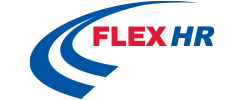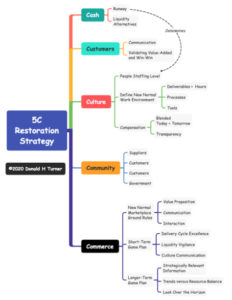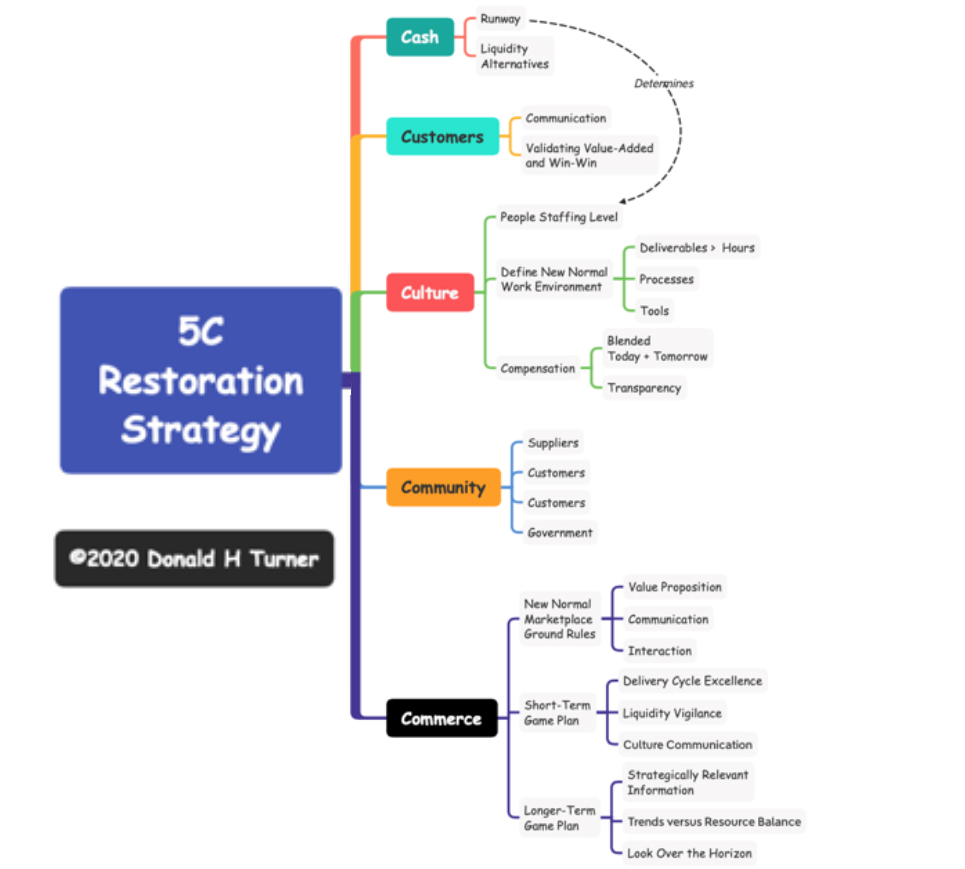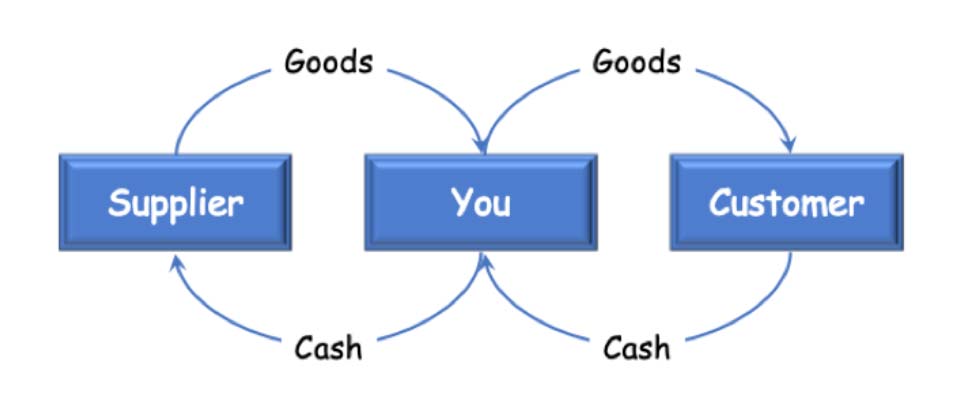Company Restoration in the New Normal – 5 C’s Restoration Strategy
By: Guest Writer Donald H Turner, Serial Turnaround and Growth Executive
 We are in our last installment of “Company Restoration in the New Normal.” I hope you are finding it informative and it is prompting some of your own thoughts about what to expect as we conduct business in this new world, we have found ourselves.
We are in our last installment of “Company Restoration in the New Normal.” I hope you are finding it informative and it is prompting some of your own thoughts about what to expect as we conduct business in this new world, we have found ourselves.
“The capacity to learn is a gift;
the ability to learn is a skill;
the willingness to learn is a choice.”
~ Brian Herbert
In Part 3 we introduced this mind map of the 5 C’s Restoration Strategy and discussed the first three: 1. cash, 2. customers and 3. culture. In this final Part 4, we finish introducing the last 2 C’s, community and commerce, and talk about the future.
 4. Community
4. Community
“Alone, we can do so little;
together, we can do so much”
~ Helen Keller
Your business operates within a community of suppliers, customers, lenders, local Government, and more. In ‘normal’ times there is always a level of dependency with each member of this community. I know many companies like to talk about partnerships over vendorships, but the reality is that there is always a recognition that if needed there are options to replace one member of your community with another – the law of supply and demand.
Given the increased requirements of conducting business in the New Normal you will be forced to have more detailed, more transparent, and more involved ‘heart-to-heart’ discussions with everyone in your value chain. You will certainly need them to be accommodating to your liquidity pressure as they will require the same of you.
If there ever was a need for commitment over involvement, the New Normal is the time.
With all due respect – and somewhat ‘tongue in cheek’ – you and your business community need to embrace the “swine mentality.”
What does this mean?
For suppliers associated with some form of fabrication, you may have to jointly work out the flow of raw materials with the flow of cash. As mentioned in the last installment, this will likely have several characteristics to it:
- You may have to interactively negotiate cash flow terms between your supplier and yourself and with your customer and yourself.
- This will require a level of trust AND transparency that all parties are most likely not accustomed to. Expect to have honest discussions around normal margins and temporary New Normal margins. For example, “I’m working at 20% less margin, can you sell to me for 20% less?” Who knows? For the short-term you may have to “open the books” to negotiate with your Suppliers and Customers.
- If, and that is a big IF, this is done successfully, would fully expect these relationships to evolve into strong shared goal partnerships as we evolve into later stages of the New Normal.
For service suppliers, the challenges may be even more difficult given that in tough times cutting back on outside services is typically one of the first burn rate reduction initiatives. With this in mind, there will be a renewed focus on monetarily quantifying your value-add to your customer. This will be a rude wake-up call for many service providers who have ignored this service-providing fundamental for way too long. Meaning paying “lip service” to it in promotional literature without routinely reviewing, refining, and enhancing their value to the marketplace.
You may have to provide a partial service to your customers for a heavily reduced amount just to keep the business. In this case, you may have to significantly broaden your customer base providing a narrower focus of services for heavily reduced prices.
All this said, with either fabrication or service suppliers, I would expect that those business communities that survive and evolve into the New Normal to represent phenomenally stronger entities. This should serve them well in the future.
We addressed customers as a stand-alone item in the 5C Restoration Strategy, but it deserves some additional discussion in context of your business community.
Your customers should be open to discussing mutually beneficial arrangements where you can offer a temporary reduced price and in turn, they will give you a long-term commitment to continue purchasing as the market becomes healthier. As with your suppliers, you will likely have discussions that involve an entirely new level of transparency.
Again, everyone is simply trying to engage in commerce again. Communication, creativity, transparency, and commitment are the ground rules for the New Normal.
Lenders have always been willing to talk about helping in a distressed situation. Trust me, they don’t want to see you fail. It costs them money, time, and a whole lot of paperwork. In the New Normal there may not be much new capital available through traditional lending institutions (we will briefly address the role of Private Equity at the end), but that is likely not your issue. Early in the New Normal, businesses will most likely be looking to buy time in dealing with existing institutional debt.
Relative to new lines of credit, I don’t see this as an impossibility if the lender is brought into the interactive and integrated discussions that you are having with your suppliers and customers. At the risk of repeating myself ad nauseum, this will require complete transparency and a commitment by all members of your business community to work together. Good and services move on the current of cash flow.
5. Commerce
“When only one party makes a profit that’s robbery; when all parties make profit that’s business.”
~ Amit Kalantri, Wealth of Words
Last but not least is the business itself. An involved topic but we will outline the key points.
New Normal Marketplace Ground Rules – you must take an honest, fresh look at your value proposition into the marketplace. Think through the real value your offering has to your customers. If you can’t answer the following four questions succinctly then you have a true value proposition problem with your business:
- “Why should the Customer listen to you?”
- “Why should the Customer listen to you now?
- “Why should the Customer buy from you?”
- “Why should the Customer buy from you now?”
There is a brave new business world coming via the New Normal and I see only quantifiably value-offering businesses surviving, much less thriving.
Short-Term Game Plan – first step in your Restoration is to deal with all of the aforementioned. In addition, have a Restoration game plan that you look at EVERY day, THROUGHOUT the day. Each day should involve laser-focused attention to balancing:
- Delivery Cycle Excellence – if your offering is still relevant in the marketplace then there will always be customers for those who can deliver real value quickly, cost-effectively, and with superior quality.
- Liquidity Management – in the early stages of the New Normal, liquidity hiccups can be deadly. Constant vigilance and constant communication backward and forward in your value chain is critical.
- Culture – remember your employees are no longer coworkers. If you have made the management to leadership transition effectively, they are your “Battle Buddies”, your “Foxhole Friends.” Communicate, communicate, communicate. Jim Cichanski, CEO of Flex HR states “Culture is a very simple definition. It’s about how employees interact through internal practices, their attitudes, ethics and the working envormnment within the company. Not necessarily what is written as policy.”
Longer-Term Game Plan – obviously the longer we look into the future the less clear our crystal ball will be. However, looking into the future is something we all must do; the alternative is to face the professional ignominy of being a Reaction Manager versus a Proactive Leader. Note, this looking into the future is where the art and science (and trust me it is clearly both) of strategy comes into play.
The fact is that we may not make strategic decisions daily, but in a lifetime of developing and executing strategy I guarantee you that you are exposed to strategically relevant information EVERY day, throughout the day.
If you don’t have the processes and tools to capture in real-time you should at least set aside some time at the end of every day and ask yourself, “what did I learn today that may impact my long-term direction at some point in the future?” This observation can involve the market in general, customers, competitors, offerings, or the underlying technology that is part of your marketplace. Sometimes it is nothing more than a tidbit of news. You need to learn how to identify potentially important strategic data. It is sad testimony to our Business School educational system that many professionals have never been taught to be “Strategic Thinkers.”
An additional observation based on a little bit of experience on the topic is to understand what is becoming LESS important in the marketplace. Many professionals only try to understand the emerging or growing trends. Remember how we said that is the “essence” of strategy – that is a good thing. However, what is often ignored from a resource planning perspective is also trying to understand what is becoming less important. It is amazing how many times I have found organizations still investing significant resources such as time, personnel, and capital, on items that are becoming less relevant in their marketplace.
Bottom line, the objective is to gather and organize strategic information in a way that it is useful when you formally sit down with your team to refine your strategy – whether that be monthly, quarterly, semi-annually, etc. (ED: timing is a function of the “velocity” of your particular marketplace).
“It’s amazing how a little tomorrow can make up for a whole lot of yesterday.”
~ John Guare, American Playwright
Final Random Thoughts
Given that in recent years I have worked with a lot of Private Equity organizations, a comment or two about how they will play and play into the New Normal seems appropriate.
First and foremost, they will be laser-focused on the survival of their current portfolio companies. They always hold back extra capital – i.e., “dry powder” – to further invest into their portfolio companies when either things have not gone as planned or there is an opportunity to grow even faster. Obviously, nothing prepared them for this economic calamity of a global scale. It is likely that some “fire sales” will be taking place as they identify portfolio businesses that simply aren’t relevant in the New Normal and need to be jettisoned.
That said, once their portfolio is relatively stabilized, expect them to be on a “rollup” frenzy – where a “rollup” is when an investment firm buys multiple smaller companies in the same market with intent of developing economies of scale and becoming more of a dominating force in that particular marketplace. With the expected business casualties of the New Normal it is likely to be what we refer to as a “target rich environment” for buying distressed companies.
As a business professional, it would be to your benefit to follow these rollup activities and look for opportunities for your own business. Ahhh, but that is a topic for another day.
Summary
As we come to a close on our look at restoring companies in the New Normal, let us review what we discussed:
- We are NOT going back to normal, there will be foundational changes in our society, our culture, and the manners of how we conduct commerce.
- Surviving – much less thriving – will involve far more involved techniques than normally associated with “Restructuring” or “Turnaround” – though the actual stages remain the same.
- Successful business Restoration will require innovative approaches to managing Cash, Customers, Culture, Community, and Commerce itself.
We are headed for a New Normal; of that I have no doubt. Here’s to hoping that we can use these “interesting times” to our advantage and make a better world for all.
Particularly in challenging times, success is NOT about knowing the answers to tomorrow – few have that prophetic ability. Future success is based on asking the right questions today.
* Information contained on this page is provided by Donald H. Turner, an independent third-party content provider. Flex HR makes no warranties or representations in connection therewith.
Flex HR specialists serve thousands of different organizations, in countless industries, with company sizes varying from a few to over 75,000 employees. They offer many levels of services including HR consulting, outsourcing (HRO), compliance, recruiting & talent acquisition, training & development, and onboarding administration.
Flex HR serves almost every industry in all 50 states, including Georgia, Florida, California, North Carolina, and Tennessee, as well as Puerto Rico, the Virgin Islands, Canada and Europe supporting U.S. subsidiaries of foreign owned companies.
Our Flex HR specialists serve thousands of different organizations, in countless industries, varying from a few to over 75,000 employees.
To Learn More about Flex HR Contact Us.
* Statistics and government guidance are rapidly changing. This is the most updated information as of the morning of 4/24/20. Small business is defined as under 500 employees.






